
Twitter incentivizes creators by sharing ad revenue: How monetization works
What's the story
It's been months since Elon Musk announced Twitter's plan to share ad revenue with creators. The microblogging platform's popular creators have been waiting for the promised payday.
Finally, the day has arrived. Twitter notified creators that they will receive their cut of ad revenue in the "next 72 hours."
Let's see how Twitter is making life better for its creators.
Context
Why does this story matter?
Twitter's decision to start sharing revenue with creators comes at a time when its dominance in the microblogging space is being threatened.
Meta's Twitter lookalike, Threads, has proved to be a strong challenger. It gained over 100 million sign-ups within days.
It is imperative for Musk and Twitter to up the ante. Attracting more creators should also help Twitter with its advertising struggles.
Eligibility
Only verified users will get a share of revenue
As previously announced by Musk, only verified creators (those with a blue tick) are eligible for a share of ad revenue. They should also have at least five million impressions in the last three months.
Twitter is paying creators on the basis of ads served in replies. They won't be paid for ads served in feeds, as it would be difficult to identify creators.
Payout
Payouts are cumulative from February
Musk first announced ad revenue sharing in February. Therefore, the payouts will be cumulative from February onward.
The first block of payments will be $5 million. The revenue split between Twitter and creators remains unclear, though.
Creators will receive their share in their Stripe account. Twitter said it plans to roll out the program broadly later this month.
Twitter Post
Ad revenue sharing is part of Twitter's creator monetization efforts
Surprise! Today we launched our Creator Ads Revenue Sharing program.
— Twitter (@Twitter) July 13, 2023
We’re expanding our creator monetization offering to include ads revenue sharing for creators. This means that creators can get a share in ad revenue, starting in the replies to their posts. This is part of our…
How much
Creators earned a few thousand dollars to about $40,000
Twitter did not mention how much creators are getting paid. So far, the company has paid creators anything from a few thousand dollars to about $40,000.
Controversial Twitter personality Brian Krassenstein received $24,305, while @Elon_alerts got around $2,200. Krassenstein has around 750,000 followers and @Elon_alerts has about 67,800 followers.
Meanwhile, Benny Johnson, a conservative political commentator and YouTuber, earned $9,456.
Importance
Monetizing ads in replies will lead to more engagement
By monetizing ads served in replies, Twitter s targeting an increase in engagement on the platform. To make money, creators will need to ensure their followers reply to their tweets.
This might also lead to more hate on the platform, as extreme emotions mean more engagement.
Creators are, however, not allowed to monetize sexual content or content about pyramid schemes, violence, drugs, etc.